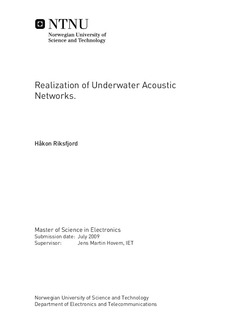Realization of Underwater Acoustic Networks.
Master thesis
Permanent lenke
http://hdl.handle.net/11250/2369475Utgivelsesdato
2009Metadata
Vis full innførselSamlinger
Sammendrag
This work contains a study of underwater acoustic networks. The concept of underwater acoustic networks has been presented with its benefits and drawbacks. An overview of the marine research areas oceanography, seismology, waterside security, marine pollution and marine biology has been made and a review of conventional methods and instrumentation committed. The research methods used today have been compared with the potential of underwater acoustic networks as a platform for maritime applications. Underwater acoustic networks were reviewed as feasible within all areas with some restrictions. The fact that respectable data rate is best achieved for nodes deployed in a high density grid give limitations on the coverage area. Battery as an energy source limits the life span of an underwater acoustic network and makes it best suited for missions for short term monitoring, if not a recharging technology is applied. The energy restrictions also put constraint on the amount of sensing done and the temporal solution in measurements. Underwater acoustic networks were found applicable for intrusion detection in waterside security to increase the range of current ultrasonic surveillance systems or realize distributed systems for passive diver detection. In oceanography and pollution monitoring current in situ sensors may enable underwater acoustic networks to do autonomous synoptic sampling of limited areas to measure a number of parameters, e.g. oxygen, turbidity, temperature and salinity. For seismic exploration this technology might save costs for permanent seismic installations in constant monitoring of producing oil fields. It might also aid marine biologists in habitat monitoring.
